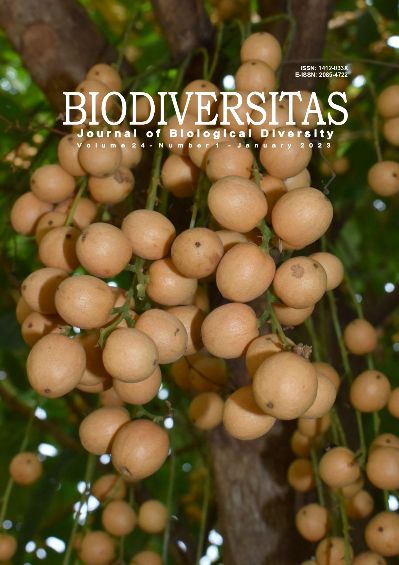The fate of mangrove ecosystem sustainability on the shrimp cultivation area in Tulang Bawang District, Lampung, Indonesia
##plugins.themes.bootstrap3.article.main##
Abstract
The exploitation of mangrove forests for economic purposes is rampant in tropical countries nowadays, particularly for shrimp farming, such as in the Lampung green belt in the front of the Java Sea. So, ensuring the sustainability of existing mangroves is the need of the hour. In view of above, this study aims to analyze the sustainability index of mangrove ecosystem management and the sustainability status of the mangrove ecosystem from the ecological, economic, social, and institutional dimensions using the Multidimensional Scaling (MDS) method through the Rapid Appraisal for Fisheries (RAPFISH) approach in East Rawajitu Sub-district, Tulang Bawang District, Lampung Province, Indonesia. The analysis revealed that mangrove ecosystem management’s sustainability index was categorized as ‘less sustainable’ (index 43.01 out of 100). Meanwhile, the social dimension (51.65) was categorized as ‘quite sustainable’, and other dimensions (ecological, economic, and institutional) were ‘less sustainable.’ Therefore, it is proposed that further development of the social dimension is a strategic way to develop the other three sustainability dimensions to achieve ecosystem sustainability as a whole in the study area. Alternative strategies that can be applied for sustainable management of mangrove ecosystems in East Rawajitu Sub-district, Tulang Bawang District are increasing coordination between stakeholders, creating formal regulations, increasing the productivity and creativity of Ikatan Istri-istri Petambak Dipasena (ISTANA), formulating an integrated mangrove ecosystem management plan program, undertaking rehabilitation efforts, increasing the role of mangrove groups, and increase the attention of researchers.
##plugins.themes.bootstrap3.article.details##
Most read articles by the same author(s)
- SAMSUL BAKRI, AGUS SETIAWAN, IDA NURHAIDA, Coffee bean physical quality: The effect of climate change adaptation behavior of shifting up cultivation area to a higher elevation , Biodiversitas Journal of Biological Diversity: Vol. 19 No. 2 (2018)
- ROMMY QURNIATI, INDRA GUMAY FEBRYANO, DINI ZULFIANI, How trust influence social capital to support collective action in agroforestry development? , Biodiversitas Journal of Biological Diversity: Vol. 18 No. 3 (2017)
- RAHMAT SAFE’I, BAINAH SARI DEWI, FERDY ARDIANSYAH, FRANSINA S. LATUMAHINA, Short Communication: Assessing the state and change of forest health of the proposed arboretum in Wan Abdul Rachman Grand Forest Park, Lampung, Indonesia , Biodiversitas Journal of Biological Diversity: Vol. 22 No. 4 (2021)
- CHRISTINE WULANDARI, AFIF BINTORO, RUSITA RUSITA, TRIO SANTOSO, DURYAT DURYAT, HARI KASKOYO, ERWIN ERWIN, PITOJO BUDIONO, Community forestry adoption based on multipurpose tree species diversity towards to sustainable forest management in ICEF of University of Lampung, Indonesia , Biodiversitas Journal of Biological Diversity: Vol. 19 No. 3 (2018)
- SAMSUL BAKRI, DELLA TIARA MONIK, AGUS SETIAWAN, GUNARDI DJOKO WINARNO, Short Communication: Assessing the relationship of Sumatran elephant’s movement (Elephas maximus sumatranus) with vegetation intensity in Kotaagung Utara, Lampung Province, Indonesia using NDVI method , Biodiversitas Journal of Biological Diversity: Vol. 23 No. 4 (2022)
- HARI KASKOYO, FERLI HARTATI, SAMSUL BAKRI, INDRA GUMAY FEBRYANO, BAINAH SARI DEWI, NUNING NURCAHYANI, Satellite based analysis of mangrove cover and density change in mangroves of Tulang Bawang District, Lampung Province, Indonesia , Biodiversitas Journal of Biological Diversity: Vol. 24 No. 5 (2023)

